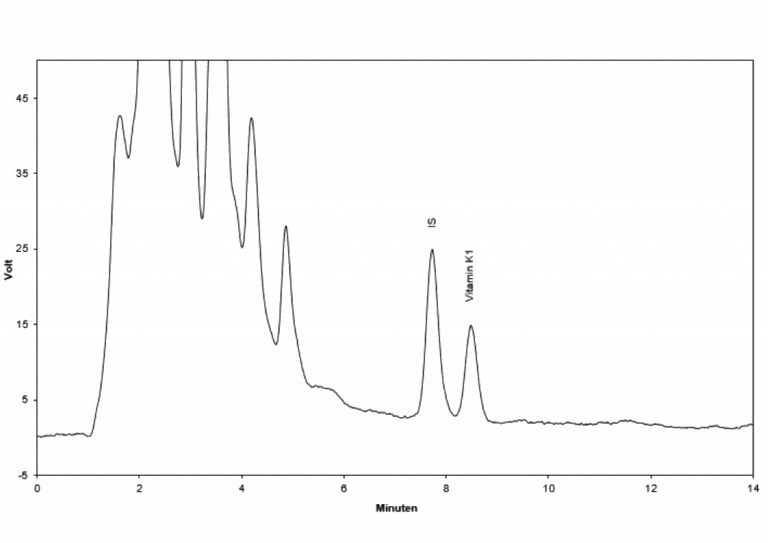Vitamin K1
Vitamin K was first discoverd by Dam 1929. He fed chicken with ether extracted food and recognized deadly bleeding. Chicken supplemented with the ether extract normalized the symptoms. The hypothetic coagulation factor was called vitamin K.
Vitamin K1 (phylloquinone) is synthesized by green plants and taken up by nutrition, whereas Vitamin K3 (menaquinone) is produced by bacteria in the gut.
Vitamin K works as cofactor of a oxygen dependent carboxylase, which is carboxylating specific glutamic acid residues in g-position. Because of that modification blood clotting factors can be activated by cleavage. In bone metabolism the g-carboxylation enables osteocalcin to bind to hydroxyapatite of the bone matrix.
Vitamin K can be stored only for a short time, whereby deficiency occur after a view days. A lack of vitamin K mainly manifests in clotting disorders. The symptoms are bleeding of skin and mucous membrane, muscle and the urogenital tract. Beside this, disorders in bone metabolism caused by a deficient modification of osteocalcin are reported.
Technical data
Sample EDTA-plasma, serum
Sample volume 1 ml
Detector Fluorescence Ex. 248 nm Em. 418 nm
Method isocratic
Determinations 100
Ordering Information
IC2400 Testkit
IC2400ko Controls (2 level each 2.2 ml lyoph.)
IC2400rp HPLC column

Principle of the method
For the determination of vitamin K1 an internal standard is added first. After a solid phase extraction on SPE-cartridges, the samples are precipitated. The supernatant is then extracted with an organic solvent and evaporated. After that the samples are resuspended and injected into the HPLC system. A post-column reduction reactor reduces Vitamin K and enables the measurement of Vitamin K with a fluorescence detector.
The isocratic separation at 30°C using a „reversed phase“ column lasts 20 minutes. The chromatograms are recorded by a fluorescence detector. The quantification is performed by the delivered plasma calibrator; the concentration is calculated by the internal standard method via integration of the peak areas resp. heights.